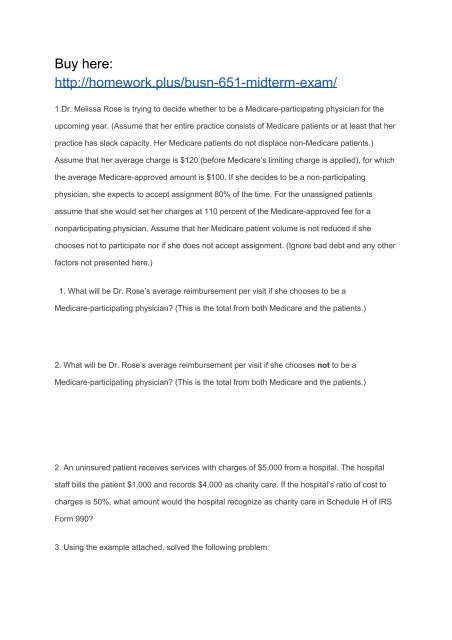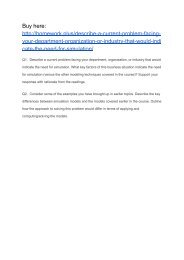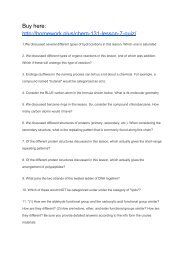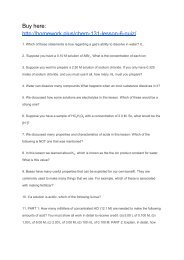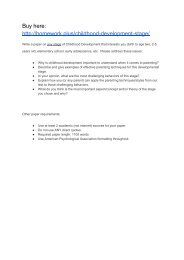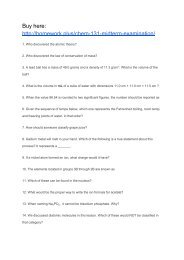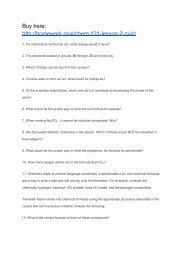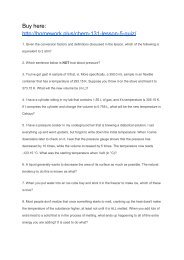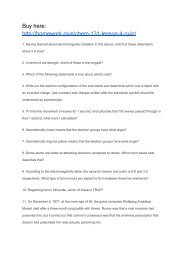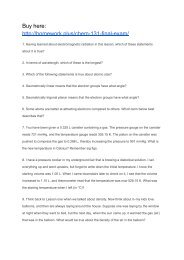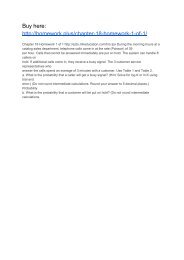BUSN 651 Midterm Exam
BUSN 651 Midterm Exam
BUSN 651 Midterm Exam
You also want an ePaper? Increase the reach of your titles
YUMPU automatically turns print PDFs into web optimized ePapers that Google loves.
Buy here:<br />
http://homework.plus/busn-<strong>651</strong>-midterm-exam/<br />
1.Dr. Melissa Rose is trying to decide whether to be a Medicare-participating physician for the<br />
upcoming year. (Assume that her entire practice consists of Medicare patients or at least that her<br />
practice has slack capacity. Her Medicare patients do not displace non-Medicare patients.)<br />
Assume that her average charge is $120 (before Medicare’s limiting charge is applied), for which<br />
the average Medicare-approved amount is $100. If she decides to be a non-participating<br />
physician, she expects to accept assignment 80% of the time. For the unassigned patients<br />
assume that she would set her charges at 110 percent of the Medicare-approved fee for a<br />
nonparticipating physician. Assume that her Medicare patient volume is not reduced if she<br />
chooses not to participate nor if she does not accept assignment. (Ignore bad debt and any other<br />
factors not presented here.)<br />
1. What will be Dr. Rose’s average reimbursement per visit if she chooses to be a<br />
Medicare-participating physician? (This is the total from both Medicare and the patients.)<br />
2. What will be Dr. Rose’s average reimbursement per visit if she chooses not to be a<br />
Medicare-participating physician? (This is the total from both Medicare and the patients.)<br />
2. An uninsured patient receives services with charges of $5,000 from a hospital. The hospital<br />
staff bills the patient $1,000 and records $4,000 as charity care. If the hospital’s ratio of cost to<br />
charges is 50%, what amount would the hospital recognize as charity care in Schedule H of IRS<br />
Form 990?<br />
3. Using the example attached, solved the following problem:
Medicare and Medicaid presently account for 50% of the volume. The hospital wishes to reduce<br />
its dependence on government payers. Assume that Medicare volume is reduced to 380 patients<br />
and Medicaid volume is reduced to 90 patients. The volume from managed-care plan #1 rises to<br />
320 patients from 300. The volume from managed-care plan #2 increases to 110 patients. Thus,<br />
total volume is unchanged at 1,000 visits. What is the new price necessary assuming all other<br />
factors are unchanged?<br />
4. You have been asked to develop a capitation rate for a primary care group based on the<br />
following projections: Service Annual Frequency/1,000 Cost per Service Inpatient Visits 100<br />
$7,000.00 Office Visits 3,000 $45.00 Lab/X-ray 500 $25.00<br />
What per-member per-month (PMPM) rate would be required to break even, ignoring any<br />
copayments?<br />
5. A hospital has contracted with an HMO to provide acute care inpatient services for $1,000 per<br />
day, subject to a 10 percent withhold. The proposed budget for inpatient services is based upon<br />
expected utilization of 600 days per 1,000 members at $1,000 per day, or $600,000 per 1,000<br />
members. The hospital risk pool will be split equally between the hospital and a primary care<br />
physician group. If only 450 days per 1,000 members were utilized in the first year, how much<br />
would the hospital be paid per 1,000 members?


